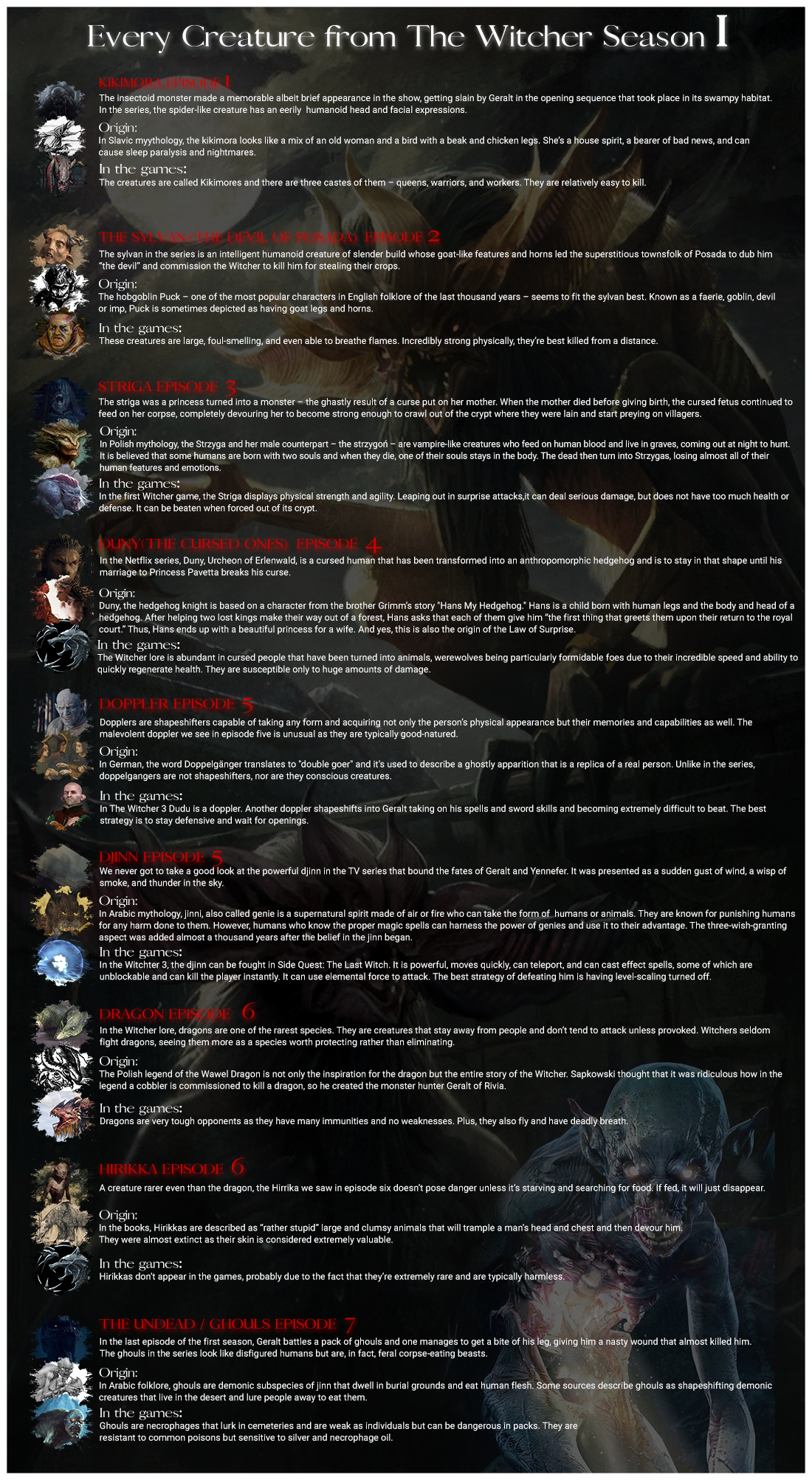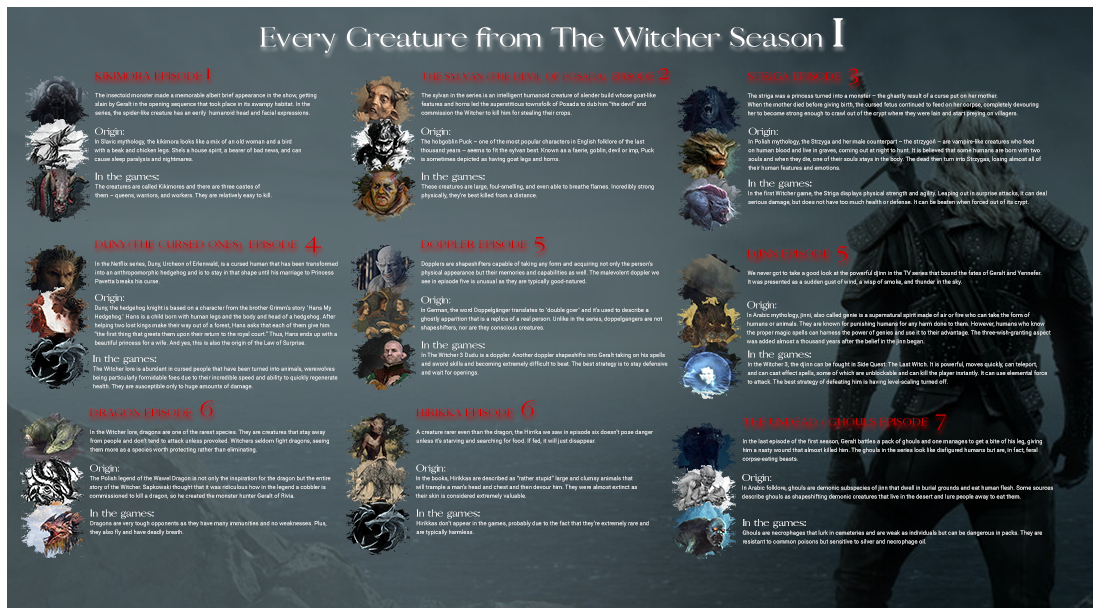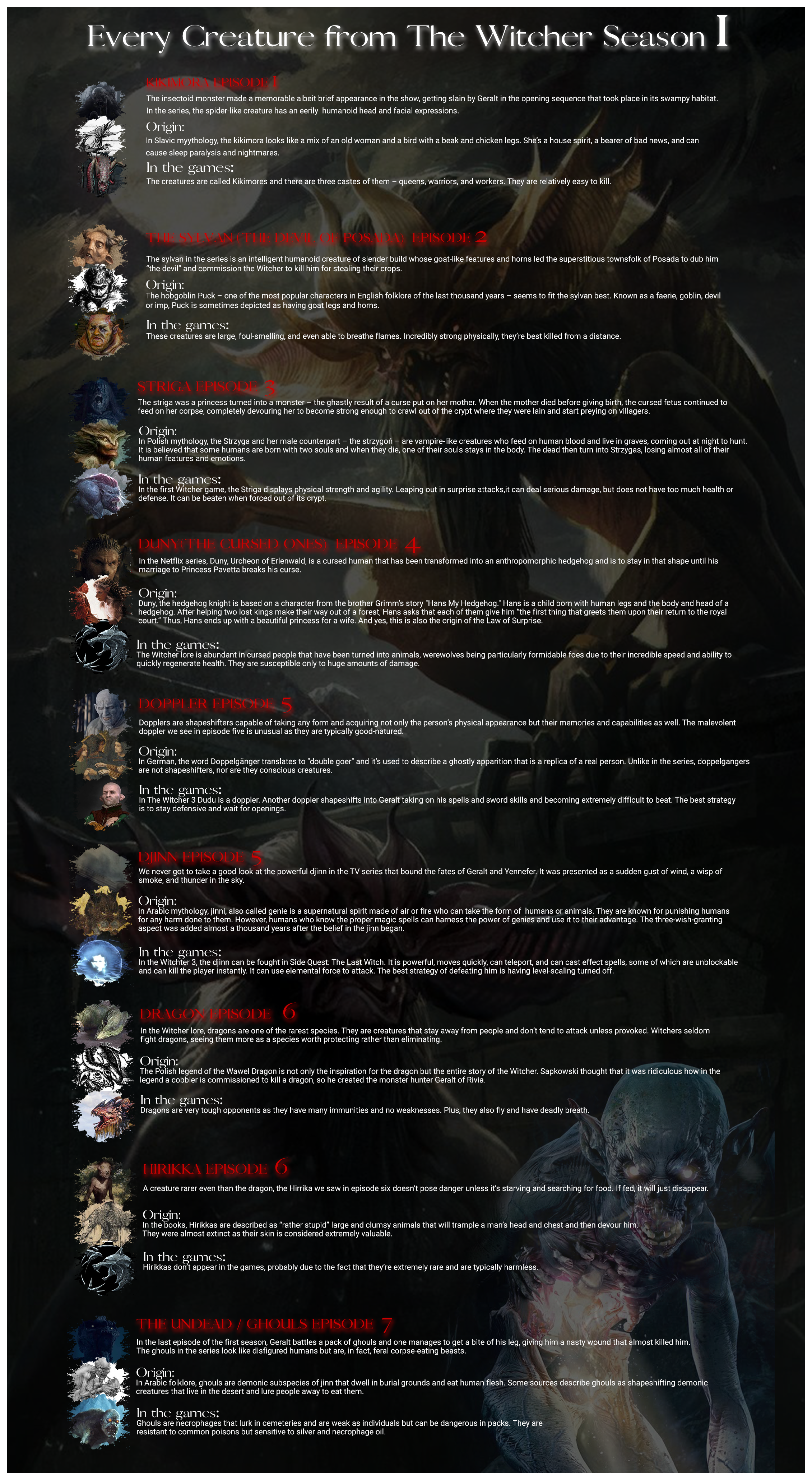Every Creature from The Witcher Season 1 – Infographic

Download a Free Poster of The Witcher’s Monsters

Since Netflix released its adaptation of the book series by Andrzej Sapkowski in December 2019, The Witcher has become a true pop culture phenomenon. It filled a void left by the Game of Thrones among fantasy TV shows fans, and a new generation of gamers re-discovered the popular action role-playing games based on the novels. And they had something for everyone. Even casino players who’d normally visit casino sites to play games found the thrill of gambling with a supernatural twist in side quests such as The Witcher 2 Dice Poker quest.
The Netflix adaptation of the dark fantasy books introduced us to a new creature almost every episode as we followed the monster hunter Geralt’s career. With resurgent interest in the both the books and the games, we take a look at each monster from the series, as well as its origins in mythology and how it’s presented in the games.
Kikimora Episode 1
The insectoid monster made a memorable albeit brief appearance in the show, getting slain by Geralt in the opening sequence that took place in its swampy habitat. In the series, the spider-like creature has an eerily humanoid head and facial expressions.
Origin: In Slavic mythology, the kikimora looks like a mix of an old woman and a bird with a beak and chicken legs. She’s a house spirit, a bearer of bad news, and can cause sleep paralysis and nightmares.
In the games: The creatures are called Kikimores and there are three castes of them – queens, warriors, and workers. They are relatively easy to kill.
The Sylvan (The Devil of Posada) Episode 2
The sylvan in the series is an intelligent humanoid creature of slender build whose goat-like features and horns led the superstitious townsfolk of Posada to dub him “the devil” and commission the Witcher to kill him for stealing their crops.
Origin: The hobgoblin Puck – one of the most popular characters in English folklore of the last thousand years – seems to fit the sylvan best. Known as a faerie, goblin, devil or imp, Puck is sometimes depicted as having goat legs and horns.
In the games: These creatures are large, foul-smelling, and even able to breathe flames. Incredibly strong physically, they’re best killed from a distance.
Striga Episode 3
The striga was a princess turned into a monster – the ghastly result of a curse put on her mother. When the mother died before giving birth, the cursed fetus continued to feed on her corpse, completely devouring her to become strong enough to crawl out of the crypt where they were lain and start preying on villagers.
Origin: In Polish mythology, the Strzyga and her male counterpart – the strzygoń – are vampire-like creatures who feed on human blood and live in graves, coming out at night to hunt. It is believed that some humans are born with two souls and when they die, one of their souls stays in the body. The dead then turn into Strzygas, losing almost all of their human features and emotions.
In the games: In the first Witcher game, the Striga displays physical strength and agility. Leaping out in surprise attacks, it can deal serious damage, but does not have too much health or defense. It can be beaten when forced out of its crypt.
Duny (The Cursed Ones) Episode 4
In the Netflix series, Duny, Urcheon of Erlenwald, is a cursed human that has been transformed into an anthropomorphic hedgehog and is to stay in that shape until his marriage to Princess Pavetta breaks his curse.
Origin: Duny, the hedgehog knight is based on a character from the brother Grimm’s story “Hans My Hedgehog.” Hans is a child born with human legs and the body and head of a hedgehog. After helping two lost kings make their way out of a forest, Hans asks that each of them give him “the first thing that greets them upon their return to the royal court.” Thus, Hans ends up with a beautiful princess for a wife. And yes, this is also the origin of the Law of Surprise.
In the games: The Witcher lore is abundant in cursed people that have been turned into animals, werewolves being particularly formidable foes due to their incredible speed and ability to quickly regenerate health. They are susceptible only to huge amounts of damage.
Doppler Episode 5
Dopplers are shapeshifters capable of taking any form and acquiring not only the person’s physical appearance but their memories and capabilities as well. The malevolent doppler we see in episode five is unusual as they are typically good-natured.
Origin: In German, the word Doppelgänger translates to “double goer” and it’s used to describe a ghostly apparition that is a replica of a real person. Unlike in the series, doppelgangers are not shapeshifters, nor are they conscious creatures.
In the games: In The Witcher 3 Dudu is a doppler. Another doppler shapeshifts into Geralt taking on his spells and sword skills and becoming extremely difficult to beat. The best strategy is to stay defensive and wait for openings.
Djinn Episode 5
We never got to take a good look at the powerful djinn in the TV series that bound the fates of Geralt and Yennefer. It was presented as a sudden gust of wind, a wisp of smoke, and thunder in the sky.
Origin: In Arabic mythology, jinni, also called genie is a supernatural spirit made of air or fire who can take the form of humans or animals. They are known for punishing humans for any harm done to them. However, humans who know the proper magic spells can harness the power of genies and use it to their advantage. The three-wish-granting aspect was added almost a thousand years after the belief in the jinn began.
In the games: In the Witcher 3, the djinn can be fought in Side Quest: The Last Witch. It is powerful, moves quickly, can teleport, and can cast effect spells, some of which are unblockable and can kill the player instantly. It can use elemental force to attack. The best strategy of defeating him is having level-scaling turned off.
Dragon Episode 6
In the Witcher lore, dragons are one of the rarest species. They are creatures that stay away from people and don’t tend to attack unless provoked. Witchers seldom fight dragons, seeing them more as a species worth protecting rather than eliminating.
Origin: The Polish legend of the Wawel Dragon is not only the inspiration for the dragon but the entire story of the Witcher. Sapkowski thought that it was ridiculous how in the legend a cobbler is commissioned to kill a dragon, so he created the monster hunter Geralt of Rivia.
In the games: Dragons are very tough opponents as they have many immunities and no weaknesses. Plus, they also fly and have deadly breath.
Hirikka Episode 6
A creature rarer even than the dragon, the Hirrika we saw in episode six doesn’t pose danger unless it’s starving and searching for food. If fed, it will just disappear.
Origin: In the books, Hirikkas are described as “rather stupid” large and clumsy animals that will trample a man’s head and chest and then devour him. They were almost extinct as their skin is considered extremely valuable.
In the games: Hirikkas don’t appear in the games, probably due to the fact that they’re extremely rare and are typically harmless.
The Undead / Ghouls Episode 8
In the last episode of the first season, Geralt battles a pack of ghouls and one manages to get a bite of his leg, giving him a nasty wound that almost killed him. The ghouls in the series look like disfigured humans but are, in fact, feral corpse-eating beasts.
Origin: In Arabic folklore, ghouls are demonic subspecies of jinn that dwell in burial grounds and eat human flesh. Some sources describe ghouls as shapeshifting demonic creatures that live in the desert and lure people away to eat them.
In the games: Ghouls are necrophages that lurk in cemeteries and are weak as individuals but can be dangerous in packs. They are resistant to common poisons but sensitive to silver and necrophage oil.

